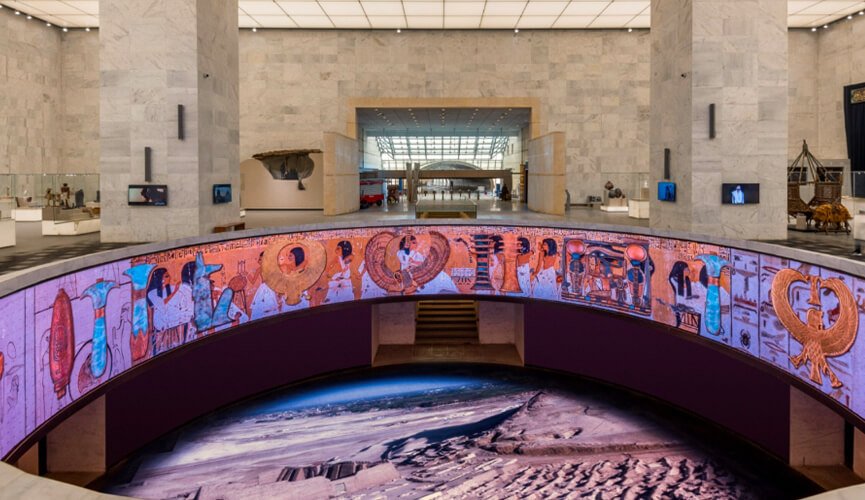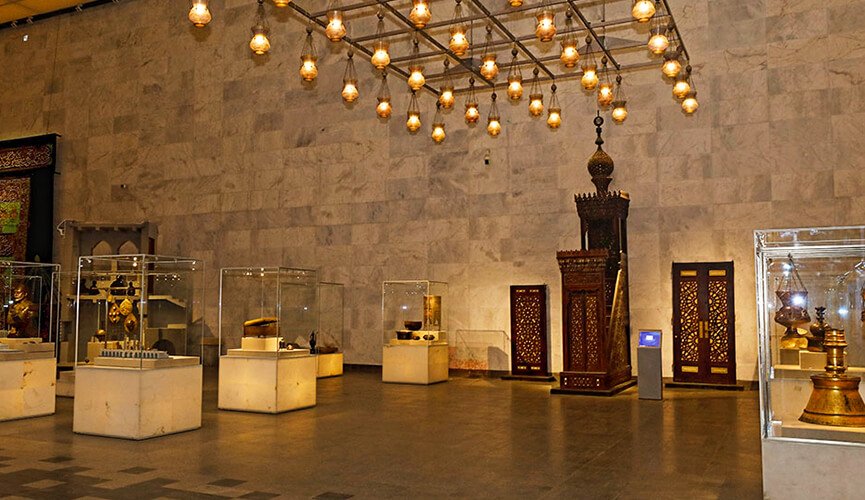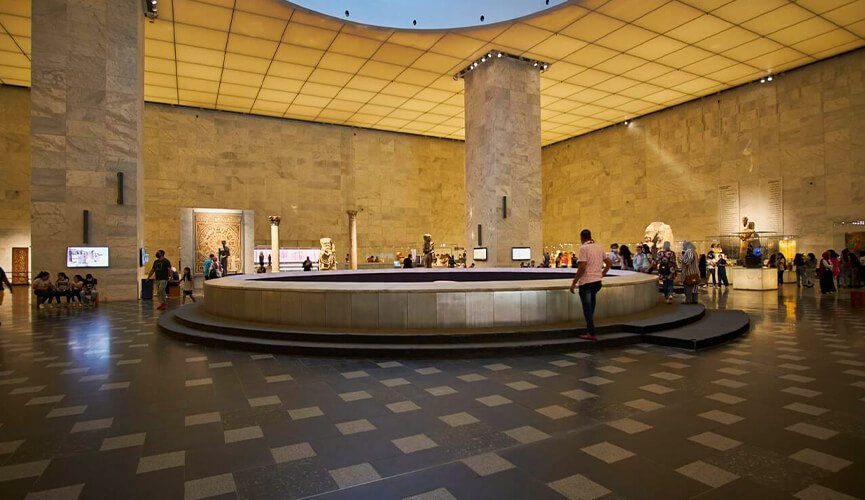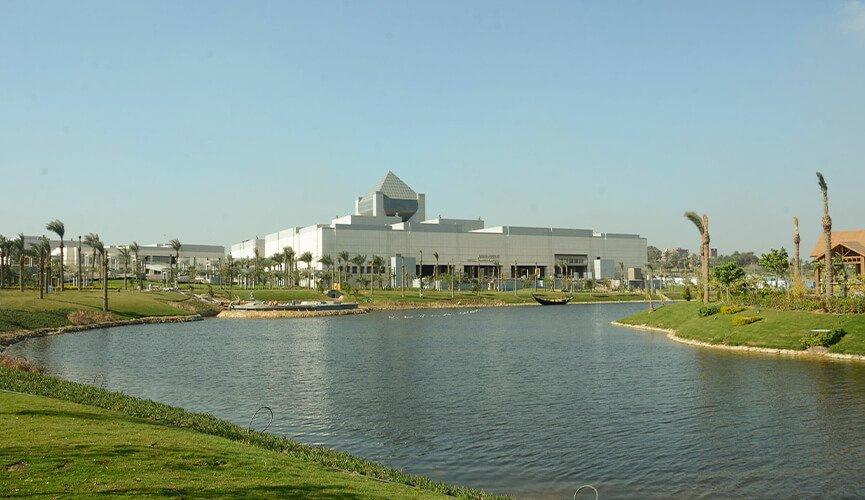The Egyptian Civilization Museum is a significant place where Egypt’s rich culture and historical history are kept safe and shown off. It is in Cairo, Egypt, and is one of the best museums in the country. Each year, millions of people come.
The museum has a vast collection of items and displays from Egypt that date back thousands of years. It tells a lot about the past of old Egypt, from the prehistoric period to the Greco-Roman period. Visitors can wander through the museum’s halls, which are set up in order of time, and be amazed by the items that show how the ancient Egyptians lived, what they made, worshipped, and what they did.
Collection of Artifacts at the Egyptian Civilization Museum

The Egyptian Civilization Museum has a large and varied collection of items from Egypt’s past that date back thousands of years. These objects tell us a lot about the ancient Egyptians’ daily life, art, faith, and achievements, and they make the museum a historical and cultural treasure trove.
Significant Artifacts
- The Rosetta Stone is one of the museum’s most well-known and essential pieces. It was found in 1799 and was very important in figuring out how the hieroglyphics were written. The stone has written on it in three different scripts: ancient Egyptian hieroglyphs, ancient Greek, and Demotic. Jean-François Champollion figured out how to read it in 1822, which led to a lot of new information about the language and history of ancient Egypt.
- Statue of Khafre: The museum has a beautiful figure of Pharaoh Khafre, who built the second-largest pyramid at Giza. The figure shows Khafre wearing the traditional names hat and holding a ritual flail. He has a royal look on his face. It shows how well the ancient Egyptians made realistic and impressive royal figures and how powerful and in charge the pharaohs were.
- Narmer Palette: The Narmer Palette is a carved slab from around 3100 BCE. It shows how Pharaoh Narmer united Upper and Lower Egypt. It has detailed Egyptian writing and colorful pictures showing the pharaoh’s victory and his essential rule. This item marks a turning point in Egyptian history, and it was made during the first dynasty, which started Egyptian culture.
- Book of the Dead: The Book of the Dead is a collection of ancient Egyptian funeral texts. The museum has a few pieces and a Book of the Dead scrolls. These books were put in graves to help the dead find their way to the next life. The Book of the Dead tells us about the ancient Egyptians’ religion, mythology, and practices related to death and the afterlife.
Importance in History and Culture
These items are essential to history and culture, and they shed light on different parts of ancient Egyptian society:
- Language and history are essential to keep alive. The Rosetta Stone was a crucial part of understanding hieroglyphs, which gave experts access to ancient Egypt’s rich history and language. It made translating many signs and texts easier, which helped us learn more about their culture, religion, and habits.
- Power and Legacy of the Pharaohs: The figure of Khafre shows how powerful and grand the pharaohs were. It shows that the ancient Egyptian masters were gods whose job was to link the gods and the people. These images show that royal power was always there and that pharaonic rule was necessary for Egyptian society.
- Unification and Cultural Identity: The Narmer Palette represents the joining of Upper and Lower Egypt, which created a centralized state and marked the start of a combined Egyptian identity. It shows how the ancient Egyptians ran their government, practiced religion, and expressed themselves through art.
- Beliefs and the future: The Book of the Dead shows how the ancient Egyptians thought about the future and how they prepared for it. It shows how much they know about the trip of the soul and how important it is to bury people correctly. These writings give us a glimpse into their religious beliefs, views of the universe, and thoughts about what happens after death.
Exhibits and Displays

The Egyptian Civilization Museum organizes exhibits and displays to give visitors a comprehensive and immersive experience of ancient Egyptian history and culture. The museum’s collections are organized thematically and chronologically, allowing visitors to explore different aspects of Egyptian civilization and gain a deeper understanding of its development over time.
Sections within the Museum
- Prehistoric Egypt: The museum starts with a part on Prehistoric Egypt, which has items from the Paleolithic, Neolithic, and Predynastic eras. Visitors can look at tools, pots, and early works of art that show how Egyptian society grew and changed in the past.
- Old Kingdom: This part is about the time of the Old Kingdom. It shows how amazing the pyramids were as buildings and how complicated the funeral rites were. Models, objects, and reliefs show how great the pharaohs were and how much they believed in the afterlife.
- Middle Kingdom and New Kingdom: The Middle Kingdom and New Kingdom parts show how advanced ancient Egyptian society was at its best. Visitors can learn about famous pharaohs like Hatshepsut, Akhenaten, and Tutankhamun by looking at their palaces, statues, and other items. The displays show what this period was like regarding war victories, faith views, and artistic successes.
- This part examines how Greek and Roman societies affected ancient Egypt. Visitors can see Hellenistic and Romanian artifacts, including statues, writings, and holy items showing how mixed Egyptian and classical customs were.
Visitor Experiences and Learning Opportunities

- Interactive Displays: The museum has displays that people of all ages can participate in. These shows include touch screens, virtual reality experiences, and video presentations that give more information about the objects and put them in context. Through engaging exhibits, people can learn about old Egyptian writing, called hieroglyphs, and the mummification process.
- Guided Tours and Audio Guides: The museum offers guided tours led by experts who explain and give more information about the exhibits. Visitors can also choose to use audio guides, which are available in many languages, and let them move through the museum at their own pace while hearing exciting information.
- Workshops and Demonstrations: The museum often has workshops and demonstrations where people can try things like making old Egyptian crafts, writing in hieroglyphics, or learning how to mummify a body. With these hands-on activities, you can learn more about the ancient Egyptians’ skills and ways of life.
- Educational Programs: The museum has programs for schools and other educational facilities. There are guided walks, classes, and teaching tools for different age groups as part of these activities. Students can learn about ancient Egypt’s history, culture, and archaeology through fun and exciting activities.
- Temporary Exhibitions: The museum has brief displays every so often that focus on specific topics or show off certain parts of old Egyptian culture. Visitors can learn more about particular issues and new things about the ancient Egyptian world through these shows.
The exhibits and displays at the Egyptian Civilization Museum are set up in a way that gives guests a whole and exciting experience. Visitors can immerse themselves in ancient Egypt’s rich history and culture through thematic and chronological parts, interactive displays, guided tours, and educational programs. They can also learn more about this exciting society.
Conclusion
The Egyptian Civilization Museum is significant as a cultural and historical organization. The museum shows the importance of Egyptian culture and history through its extensive collection, educational exhibits, and engaging displays. This gives tourists a unique chance to learn about and respect the old society.
The museum is essential for protecting and sharing Egyptian history and culture. Showing objects and explaining how they fit into history ensures that the history of ancient Egypt will be known and understood by people now and in the future. The museum’s promise to keep these gems safe and put them on show is significant for protecting Egypt’s cultural history.

